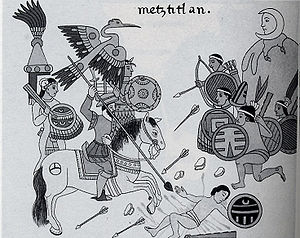文化冲击
文化冲击,或文化震惊、文化休克(英语:culture shock),是指一个人或者一个组织身处不同国家的文化或不一样的环境中而经受的一种困惑、焦虑的状况,未必会产生严重后果。该词在1954年由Kalervo Oberg首先提出。Michael Winkelman等其他学者随后展开了对文化冲击的研究工作。文化冲击的研究领域属于跨文化交际。

四个阶段
编辑文化冲击主要有四个阶段,主要预测本身的文化(Heritage culture)与新的文化(Host culture)的相互影响。
蜜月期
编辑在这个阶段,新文化和旧文化之间的差别之处 会迸发出浪漫的火花。例如,初到一个新的国家,人们可能会爱上这里的新奇的食物、生活的节奏、还有当地人不同的生活习惯。在这最初的几周内,大多数人都会被这些新的文化所深深地吸引。人们会和那些讲着当地语言的并且对外国人十分有礼貌的当地人愉快地交流。 就像大多数蜜月一样,这样的阶段最终会告一段落[3]。
过渡期
编辑一段时间之后(大约三个月,每个人的时间都不同),新旧文化的不同之处渐渐越来越明显,进而会产生很多焦虑。随着各种困难带来的挫败感和持续经历不愉快的事情带来的愤怒,新文化的兴奋感最终会消失殆尽。这最终会导致人们对新文化产生抵制情绪。 在这个阶段,体验者开始逐渐意识到生活在异国的不便——主要体现在对于语言,交通,购物,饮食等等日常生活的小细节上。因此体验者会在心理上受挫败感。对于“新家”和“旧家”都有说不清的矛盾心态。对于新家,体验者有着排斥和冷眼相待的心态。比如说,总是刻意扭曲当地人的行为和语言,潜意识的对当地人产生种族偏见。对于“旧家”,也因为有种报喜不报忧的心态,以至于与之前的关系网络脱节。在这个阶段,体验者容易抑郁。 此阶段最终要的变化是沟通:人们在适应一个新文化的时候,往往会因为不适应新环境和见不到熟悉的人而感到孤独、想家。 例如,留学生在异国他乡时,可能会:
调整期
编辑同样的,一段时间之后(通常6-12个月),人们慢慢地熟悉了新的文化,并且形成了新的日常生活习惯。他们知道在现阶段应该期待的是什么,并且现在的国家并不像最开始感觉的那么新奇特。人们开始重新关注基本的生活,并且日常生活变得“正常”起来。他们开始慢慢地寻找解决文化困难的方法,并且积极地接受这个新的文化。新的文化慢慢地在人们心中形成,并且对文化消极的举动和反应正在慢慢减少。
适应/融入期
编辑最终阶段是人们能够完全地融入进新文化,并且感到很舒适愉快。最终阶段不是指全部人生的最终阶段,人们总是在会在各种新文化的初期感到冲击,比如口音、语言。 经历了低潮一般的挣扎期,体验者开始逐渐接受了新环境和新的思维方式。他/她可以意识到其实人都是社会的产物所以当他站在一个新的文化和历史的视角看问题,穿着当地人的鞋走当地的路时,他/她对于在第二阶段产生的偏见逐渐消除。同时,语言的进步,人际关系的加强也会让受到文化冲击的体验者更加自信起来。最后,体验者能够为“新家”作贡献也被“新家”的成员所接受。这样就开始了建立新生活的良好周期。大部分人在这个阶段自我定义为多元化人,因为他们能够同时从多个文化背景出发看待,解释和处理问题。
逆文化冲击
编辑一些适应外国生活的人在回国后亦会感到难以适应本国的生活,这种现象称为逆文化冲击(Reverse culture shock,又作re-entry shock或own culture shock[4])。有人认为这背后有理想化和期待两种原因。当人们在国外生活时,往往会美化自己的记忆,专注于母国美好的一面;而另一方面,人们又往往会在潜意识中期待,自己在国外生活时,母国不会发生任何变化。因此在回国之后,种种不适应便造成了逆文化冲击的产生[5]。
影响人们适应因素
编辑距离远近
编辑文化上,另一地方的语言或行为与自身成长地方差很大的话较难适应。如气候上,马来西亚人比芬兰的人更易适应新加坡的文化。或者语言上,德国人比起法国人更易适应英国的生活。
个人与另一文化契合程度
编辑如果某人是一个严谨的个人主义者,他会比较适合一些个人主义的国家,如美国。
适应策略
编辑心理学家Berry归纳出一个四分模型来解释人们的适应策略。
| 四分模型 | 对外来文化 | ||
|---|---|---|---|
| 更负面 | 更正面 | ||
| 对本身文化 | 更正面 | 排外 | 整合 |
| 更负面 | 解构 | 同化 | |
The fourfold model is a bilinear model that categorizes acculturation strategies along two dimensions. The first dimension concerns the retention or rejection of an individual's minority or native culture (i.e. "Is it considered to be of value to maintain one's identity and characteristics?"), whereas the second dimension concerns the adoption or rejection of the dominant group or host culture. ("Is it considered to be of value to maintain relationships with the larger society?") From this, four acculturation strategies emerge.[6]
- 同化 occurs when individuals adopt the cultural norms of a dominant or host culture, over their original culture. Sometimes it is forced by governments.
- 排外 occurs when individuals reject the dominant or host culture in favor of preserving their culture of origin. Separation is often facilitated by immigration to ethnic enclaves.
- 整合 occurs when individuals are able to adopt the cultural norms of the dominant or host culture while maintaining their culture of origin. Integration leads to, and is often synonymous with biculturalism.
- 解构 occurs when individuals reject both their culture of origin and the dominant host culture.
Studies suggest that individuals' respective acculturation strategy can differ between their private and public life spheres.[7] For instance, an individual may reject the values and norms of the dominant culture in his private life (separation), whereas he might adapt to the dominant culture in public parts of his life (i.e., integration or assimilation).
像语言学习,文化也有学习关键期。例如香港往加拿大移民跨年龄研究中发现,住了20年后,0-15岁的人会比16-30岁的人更认同加拿大的文化[8]。换言之,年纪较大的人们即使在新地方生活了很久,他们还是大多自觉自己是原本文化的人,较难从心里认同新的文化。
参见
编辑参考文献
编辑引用
编辑- ^ Black, J. Stewart; Mendenhall, Mark. The U-Curve Adjustment Hypothesis Revisited: A Review and Theoretical Framework. Journal of International Business Studies. 1991-06, 22 (2): 225–247. ISSN 0047-2506. doi:10.1057/palgrave.jibs.8490301.
- ^ Harbaugh, William; Levinson, Arik; Wilson, David. Reexamining the Empirical Evidence for an Environmental Kuznets Curve. Cambridge, MA. 2000-05.
- ^ Oberg, Kalervo. Cultural Shock: Adjustment to New Cultural Environments. Practical Anthropology. 1960-07, os–7 (4): 177–182. ISSN 0032-633X. doi:10.1177/009182966000700405.
- ^ Woesler, M. A New Model of Cross Cultural Communication: Critically Reviewing, Combining and Further Developing the Basic Models of Permutter, Yoshikawa, Hall, Hofstede, Thomas, Hallpike, and the Social Constructivism. Comparative cultural science 1. Bochum/Berlin: European University Press. 2006 [2022-06-07]. ISBN 978-3-89966-188-0. OCLC 180723503. (原始内容存档于2022-06-07).
- ^ Martin, Hank "Dealing with Reverse Culture Shock." Breaking Trail Online. http://brktrail.com/rshock/ (页面存档备份,存于互联网档案馆)
- ^ Berry, John W. Immigration, Acculturation, and Adaptation. Applied Psychology. 1997, 46 (1): 10. doi:10.1111/j.1464-0597.1997.tb01087.x.
- ^ Arends-Tóth, Judit; van de Vijver, Fons J. R. Domains and dimensions in acculturation: Implicit theories of Turkish–Dutch. International Journal of Intercultural Relations. February 2004, 28 (1): 19–35. doi:10.1016/j.ijintrel.2003.09.001.
- ^ Cheung, Benjamin Y.; Chudek, Maciej; Heine, Steven J. Evidence for a sensitive period for acculturation: younger immigrants report acculturating at a faster rate. Psychological Science. 2011-02, 22 (2): 147–152 [2019-03-21]. ISSN 1467-9280. PMID 21189354. doi:10.1177/0956797610394661. (原始内容存档于2019-05-18).
文献
编辑- Macionis, John, and Linda Gerber. "Chapter 3 - Culture." Sociology. 7th edition ed. Toronto, ON: Pearson Canada Inc., 2010. 54. Print.
- Pedersen, Paul. The Five Stages of Culture Shock: Critical Incidents Around the World. Contributions in psychology, no. 25. Westport, Conn: Greenwood Press, 1995.
- Barna, LaRay M. "HOW CULTURE SHOCK AFFECTS COMMUNICATION." Communication 5.1 (n.d.): 1-18. SocINDEX with Full Text. EBSCO.29 Sept.2009.web.
- Oberg, Dr. Kalervo. "Culture Shock and the problem of Adjustment to the new cultural environments". World Wide Classroom Consortium for International Education & Multicultural studies. 29 Sept 2009.
- Mavrides, Gregory PhD “Culture Shock and Clinical Depression.” Foreign Teachers Guide to Living and Working in China. Middle Kingdom Life, 2009. Web. 29 Sept. 2009.
- https://web.archive.org/web/20171004135950/http://www.thewanderlanders.com/the-four-stages-of-adjusting-to-a-new-culture/